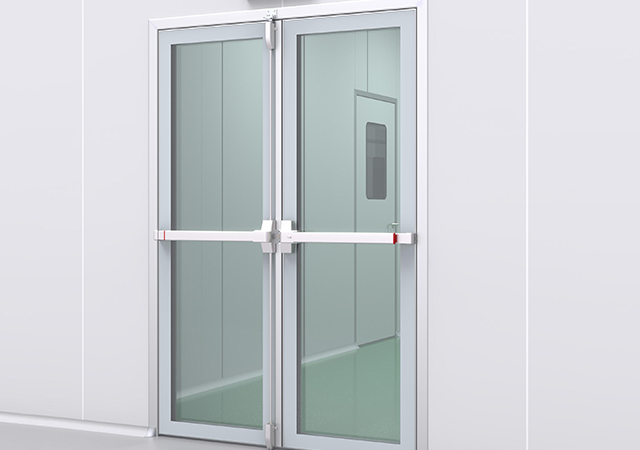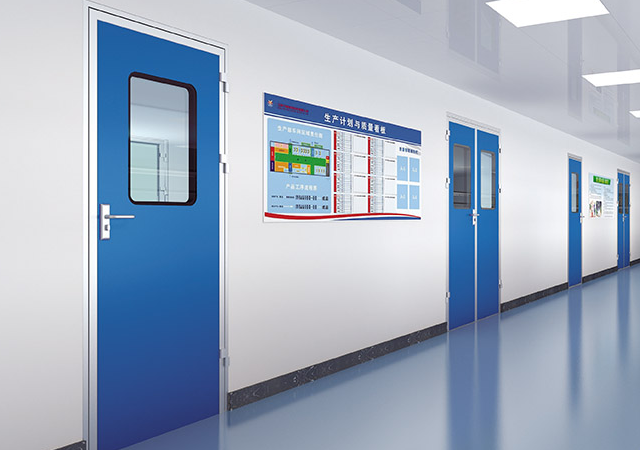
Essential Components: Navigating the World of Air Handling Unit Parts & Accessories
- By:hqt
- 2023-10-17
- 29
Air Handling Units (AHUs) constitute integral elements within HVAC (Heating, Ventilation, and Air Conditioning) systems, particularly in commercial, industrial, and institutional edifices. They assume a pivotal role in upholding indoor air quality, temperature regulation, and overall occupant comfort. AHUs orchestrate the essential functions of air circulation, filtration, cooling, heating, as well as humidity management, striving to establish a conducive and healthful indoor milieu.

For an Air Handling Unit to achieve peak performance, it hinges greatly on the quality and functionality of its various air handling unit parts & accessories. These components and accessories occupy a critical niche, ensuring that HVAC systems operate with maximum efficiency and efficacy.
Primary Components of an AHU
Fans: The Heart of Airflow
Fans serve as the central components responsible for moving air within an Air Handling Unit (AHU) and throughout the building. Proper fan selection is crucial for efficient operation.
1) Types of Fans Used:
- Centrifugal Fans: These fans are common in AHUs and are efficient at moving large volumes of air. They come in various designs, such as forward-curved, backward-curved, and radial-blade, each suited for different applications.
- Axial Fans: Axial fans are used when high airflow rates at lower pressures are required, such as in ventilation systems.
2) Importance of Fan Selection:
Fan selection depends on factors like the system's airflow requirements, pressure drop across filters and coils, and energy efficiency goals. An appropriately selected fan ensures the AHU operates efficiently, minimizing energy consumption and operational costs.
Filters: Cleaning the Air
Filters in an AHU plays a critical role in improving indoor air quality by removing contaminants from incoming air.
1) Different Types of Filters:
- HEPA Filters (High-Efficiency Particulate Air): HEPA filters are highly effective in capturing tiny particles, making them ideal for environments requiring the highest air quality, such as healthcare facilities or laboratories.
- Activated Carbon Filters: These filters excel at removing odors, volatile organic compounds (VOCs), and gases from the air. They are commonly used in AHUs to enhance air freshness.
Coils: Conditioning the Air
Coils within an AHU is responsible for either cooling or heating the air, depending on the HVAC system's requirements.
1) Cooling Coils vs. Heating Coils:
- Cooling Coils: These coils contain refrigerants and are used to remove heat from the air, reducing its temperature.
- Heating Coils: Heating coils utilize hot water or steam to raise the temperature of the air.
2) Maintenance Tips:
Regular cleaning and inspection of coils are essential to maintain their efficiency. Ensuring that coils are free from dust or debris prevents reduced heat transfer and inefficient temperature control.
Dampers: Directing Airflow
Dampers regulate the flow of air within the AHU and the distribution of air throughout the building.
- Types of Dampers:
- Volume Control Dampers: These dampers modulate airflow by adjusting the size of the duct opening, allowing for precise control of air distribution.
- Fire Dampers: Fire dampers are designed to close automatically in the event of a fire, preventing the spread of smoke and flames through the ductwork.
- Importance in Maintaining Air Balance:
Properly functioning dampers help maintain the desired air balance within the building, ensuring even temperature distribution and adequate ventilation.
Regular inspection and maintenance of dampers are crucial for their reliable operation.
Key Accessories and Add-ons
Humidifiers/Dehumidifiers: Regulating Moisture Levels
Humidifiers and dehumidifiers stand as indispensable additions to Air Handling Units (AHUs), actively managing indoor humidity levels to enhance occupant comfort and overall air quality.
- Humidifiers: These devices introduce moisture into the air when required, averting dryness-related discomfort, such as parched skin, respiratory irritation, and the build-up of static electricity.
- Dehumidifiers: Dehumidifiers extract excess moisture from the air, mitigating issues like mold proliferation, musty odors, and condensation on windows and surfaces.

Sound Attenuators: Mitigating Noise Disturbance
Sound attenuators, as supplemental components, play a pivotal role in curtailing noise emissions stemming from AHUs, thereby fostering a tranquil indoor environment.
- Sound Attenuation Technology: These components employ diverse sound-absorbing materials and design methodologies to diminish the propagation of noise originating from fans, airflow, and other AHU constituents.
- Significance of Noise Abatement: Noise pollution can be disruptive, adversely impacting occupant comfort and productivity. Sound attenuators preserve a hushed and conducive indoor ambiance.
Heat Recovery Devices: Elevating Energy Efficiency
Heat recovery devices emerge as valuable augmentations that capture and recycle thermal energy from outgoing air, elevating the global energy efficiency of an AHU.
- Assorted Heat Recovery Devices: These encompass an array of apparatuses, such as heat exchangers and enthalpy wheels, facilitating the transference of heat between incoming and outgoing air streams.
- Energy Efficiency Gains: These mechanisms curtail the heating or cooling load on the HVAC system, resulting in diminished energy consumption and operational expenses.
Vibration Isolators: Safeguarding Equipment and Quieting Operation
Vibration isolators, deemed indispensable accessories, shield AHU components from harm and curtail the transmission of vibrations and noise to the building infrastructure.
- Vibration Control: Typically situated between the AHU and the building structure, these mechanisms adeptly absorb vibrations engendered during operation.
- The Import of Vibration Mitigation: Adept vibration control not only preserves equipment integrity but also forestalls the transmission of noise, thereby perpetuating a serene indoor environment.
Importance of Regular Maintenance
Prolonging the Lifespan of the AHU
Regular maintenance of an Air Handling Unit (AHU) is paramount to extending its operational lifespan and ensuring it remains in optimal condition over time.
- Preventing Wear and Tear: Routine inspections, cleaning, and component replacements help mitigate the effects of wear and tear on the AHU's critical parts.
- Preserving Equipment Integrity: Well-maintained AHUs are less prone to mechanical failures, corrosion, and other factors that can prematurely degrade the unit.
Ensuring Efficiency and Energy Savings
Consistent maintenance practices are essential to guarantee the efficiency of an AHU, which translates to energy savings and reduced operational costs.
- Efficiency Optimization: Cleaning or replacing filters, coils, and other components as needed ensures that the AHU operates efficiently, minimizing energy consumption.
- Environmental Responsibility: Improved efficiency not only reduces energy bills but also contributes to a lower carbon footprint, promoting sustainability.
Preventing Costly Breakdowns and Repairs
Regular maintenance is a proactive strategy to prevent unexpected breakdowns and costly repairs, which can disrupt operations and strain budgets.
- Early Issue Detection: Regular inspections can identify potential issues before they escalate into major problems, allowing for timely intervention.
- Cost Savings: Addressing maintenance needs promptly is often more cost-effective than dealing with emergency repairs or replacing components due to neglect.
As a Vital Role of Air Handling Units (AHUs) in HVAC Systems: Achieving Comfort, Air Quality, and Efficiency
Within the domain of HVAC systems, the Air Handling Unit (AHU) assumes a pivotal role, tasked with upholding indoor comfort and air quality within commercial, industrial, and institutional structures. The seamless operation of AHUs hinges upon the harmonious interaction of their fundamental constituents and the incorporation of enhancements, essential air handling unit parts & accessories.
As we traverse the realm of Air Handling Unit components and add-ons, it becomes apparent that the interplay between these elements holds utmost significance in the establishment of welcoming and healthful indoor settings, all the while championing sustainability and economic prudence.
-
 Cleanroom Glass Windows Are The Key to Maintaining a Clean Environment
Cleanroom Glass Windows Are The Key to Maintaining a Clean Environment -
 Top Aluminium Profile Manufacturers in China: Leading the Global Market
Top Aluminium Profile Manufacturers in China: Leading the Global Market -
 The Evolution of Air Tight Sliding Doors
The Evolution of Air Tight Sliding Doors -
 AHU Aluminium Profile: A Comprehensive Guide
AHU Aluminium Profile: A Comprehensive Guide -
 The Importance of Choosing the Right Cleanroom Door in Vietnam
The Importance of Choosing the Right Cleanroom Door in Vietnam -
 The Benefits of Hospital Automatic Doors: Enhancing Efficiency and Safety
The Benefits of Hospital Automatic Doors: Enhancing Efficiency and Safety -
.jpg) The Best Bathroom Door Manufacturers - Unlocking Endless Possibilities!
The Best Bathroom Door Manufacturers - Unlocking Endless Possibilities! -
 Unlock the Possibilities with AJ Manufacturing Doors
Unlock the Possibilities with AJ Manufacturing Doors -
 Make a Statement with Manufactured Home Interior Doors!
Make a Statement with Manufactured Home Interior Doors! -
 what is aluminum profile? Aluminum Profiles for Your Home is the best option
what is aluminum profile? Aluminum Profiles for Your Home is the best option
-
 Next-Gen Medical Cleanroom Access: Introducing the Cleanroom Steel Door Solution
Next-Gen Medical Cleanroom Access: Introducing the Cleanroom Steel Door Solution -
 Linear Bar Grille Air Conditioning Diffuser with 0° Angle Blades for Perfect Airflow
Linear Bar Grille Air Conditioning Diffuser with 0° Angle Blades for Perfect Airflow -
 The Sleek and Efficient Linear Slot Diffuser for Air Vent
The Sleek and Efficient Linear Slot Diffuser for Air Vent -
 Double-Swing Glass Doors - Modern Laboratory Cleanroom Doors
Double-Swing Glass Doors - Modern Laboratory Cleanroom Doors -
 Superior Aluminium Glass Swing Door - Pharmaceutical Cleanroom Door
Superior Aluminium Glass Swing Door - Pharmaceutical Cleanroom Door -
 E-ZONG Leads the Way in China's Medical Lead Protection Doors: Innovation for Safety and Efficiency
E-ZONG Leads the Way in China's Medical Lead Protection Doors: Innovation for Safety and Efficiency -
 E-ZONG: Leading the Suppliers of Glass Airtight Automatic Doors for Safer, Cleaner Spaces
E-ZONG: Leading the Suppliers of Glass Airtight Automatic Doors for Safer, Cleaner Spaces -
 How Wall Air-Tight Swing Doors Ensure Clean Environments With Secure & Silent
How Wall Air-Tight Swing Doors Ensure Clean Environments With Secure & Silent -
 Seamless Automatic Cleanroom Sliding Doors: Smooth, Safe, and Hygienic Solutions
Seamless Automatic Cleanroom Sliding Doors: Smooth, Safe, and Hygienic Solutions -
 Elegant & Durable: Premium Swing Door Protection for Hospitals
Elegant & Durable: Premium Swing Door Protection for Hospitals

Guangzhou Yizhong Aluminum Industry Co., Ltd.
We are always providing our customers with reliable products and considerate services.
We are always providing our customers with reliable products and considerate services.










Speak Your Mind